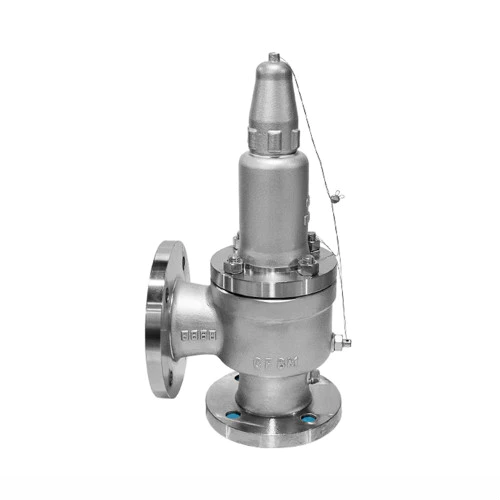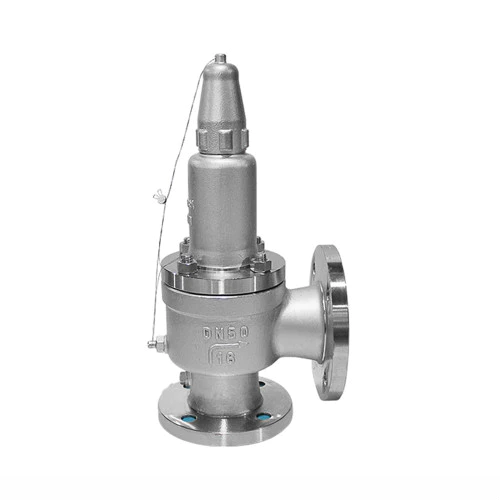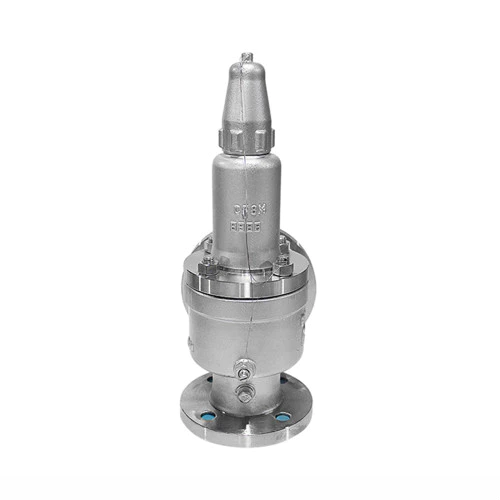COVNA Products



COVNA Spring-Loaded Flange-End Safety Valves
COVNA spring-loaded flanged safety valves are designed for boilers, pressure vessels, and piping systems, ensuring system pressure does not exceed the set point, effectively protecting personnel and equipment. Featuring a high-strength spring-loaded structure, the valves offer rapid response and reliable sealing, making them suitable for high-pressure, high-temperature applications involving both gaseous and liquid media.
- Model: Safety Relief Valve
- Size Range: 3/4" to 16"
- Pressure Range: 1.6 to 10MPa
- Material: WCB, Stainless Steel
Key Features
Various construction options: Available with threaded caps, packing levers, flat levers, and locking devices to meet diverse operating requirements.
Widely applicable media: Steam, water, air, oil, and other non-corrosive fluids.
High-temperature and pressure-resistant: Operating temperature up to 350°C (≤400°F).
Dual-function: Provides instantaneous opening characteristics of a safety valve in gas systems and proportional opening characteristics of a pressure relief valve in liquid systems.
Multiple standard flanges: Compatible with international standards such as GB, DIN, and ANSI.
Economical and durable: Lower cost and easier maintenance than other safety valves.
Technical Parameters
| Parameter | Specification Range |
|---|---|
| Nominal Diameter | 3/4" ~ 16" (DN20 ~ DN400) |
| Nominal Pressure | 1.6 ~ 10MPa (16bar ~ 64bar) |
| Valve Body Material | WCB Carbon Steel, Stainless Steel 304/316/316L |
| Connection Method | Flange Connection (GB, DIN, ANSI) |
| Working Temperature | -29℃ ~ 350℃ (some models up to 450℃) |
| Applicable Media | Steam, Water, Air, Oil, etc. |
| Manufacturing Standards | GB, DIN, ANSI |
Applications
Industrial boilers and steam systems
Pressure vessels and storage tanks
Pipelines in the chemical, petrochemical, and energy industries
Air compressors, dryers, and heat exchange equipment
Food, pharmaceutical, and paper industries
Why Choose COVNA
Over 25 Years of Industry Experience: Serving Industrial Customers Globally with Stable and Reliable Quality
Strict Quality Control: ISO 9001 Certified
Global Delivery Capabilities: Exporting to Europe, America, Southeast Asia, the Middle East, and other countries and regions
Technical Support: Providing selection guidance, installation and commissioning, and after-sales service
The actuator on my automated valve operates, but the valve won’t turn. Why?
Most likely the valve stem or actuator coupling is broken.
Why doesn’t my valve open or close completely when the actuator operates it?
The electric actuator limit switches or the pneumatic actuator position stops are not correctly adjusted.
When I energize the solenoid on my pneumatic actuated valve, the valve won’t turn. How come?
Probably because there is no air pressure to the solenoid or dirt has jammed it. Also, debris might be trapped inside the valve. Or, the air pressure is not sufficient to operate the actuator. Remember: measure air pressure at the actuator, not at the compressor.
Can I buy an actuator from one manufacturer and mount it to a valve from another manufacturer?
Maybe. First, be sure that the actuator torque output is sufficient to turn the valve reliably. Second, you will have to fabricate a custom mounting bracket and coupling to connect the actuator to the valve.
What happens if I lose power to my electric actuator in the middle of an actuation cycle?
The valve will stop somewhere between full open and close. When power is reapplied to the original circuit, the actuator will complete the cycle.
I ordered a fail open pneumatic actuated valve by mistake. I needed a fail closed one. What can I do?
To make the change just remove the actuator from the valve and turn it, or the valve stem, 90 degrees and remount the actuator.
I’ve installed my automated valve in the line, but now I don’t know if the valve is in the open or closed position. How can I find out?
Remove the actuator from the valve and check the valve stem. Most ball valves have stem flats at right angles to the flow when the valve is in the off position. On butterfly valves check the stem flow arrow marking.
Do I have to have the solenoid valve that controls the air supply to my pneumatic actuator mounted right on the actuator?
Remove the actuator from the valve and check the valve stem. Most ball valves have stem flats at right angles to the flow when the valve is in the off position. On butterfly valves check the stem flow arrow marking.
How do I wire up my electric actuator?
Check the electric wiring schematic that came with the actuator for the correct hookup. Sometimes a copy is inside the actuator cover. If it is missing, don’t guess about the connections. Call the manufacturer for a schematic.
I’ve just installed an electric actuated valve and when I power it, it turns the valve 360 degrees and won’t shut off. What’s wrong?
The actuator is wired incorrectly (check the schematic accompanying the actuator), or the external control switch is not the correct type for the actuator.
My electric actuators cycle time is way too fast, can I slow it down?
Not unless you bought it with an optional speed control.
I just replaced a solenoid valve with an electric actuated valve and it won’t work. Why?
Actuators and solenoid valves require different types of electrical control switches. SPDT for actuators, SPST for solenoids. Check the actuator wiring schematic for the correct wiring and switch type.












